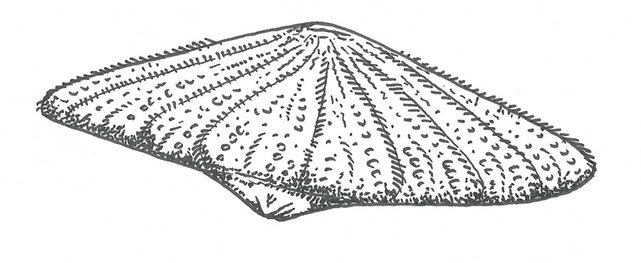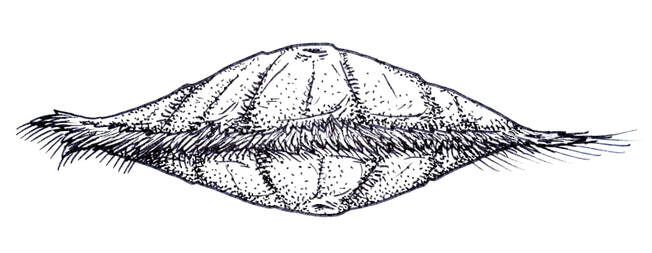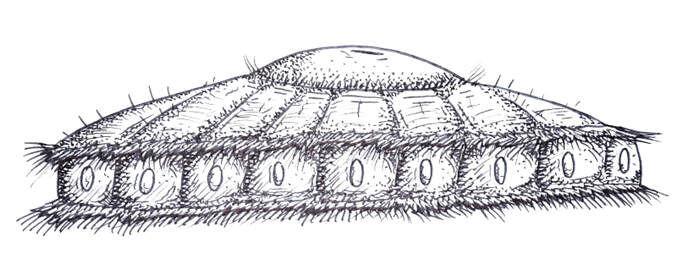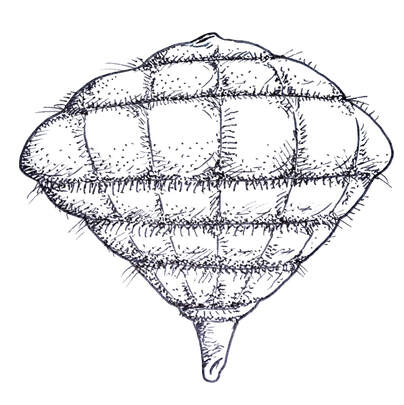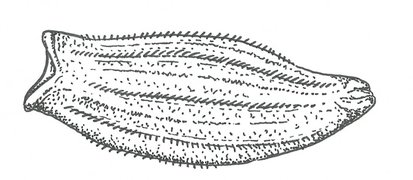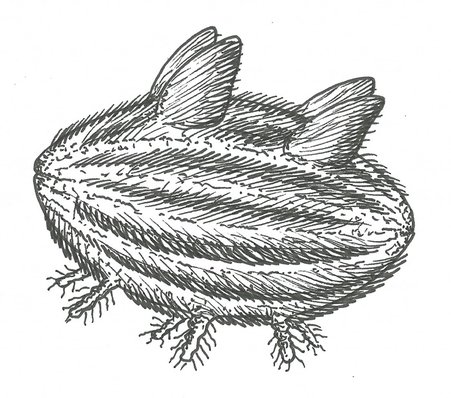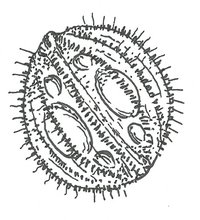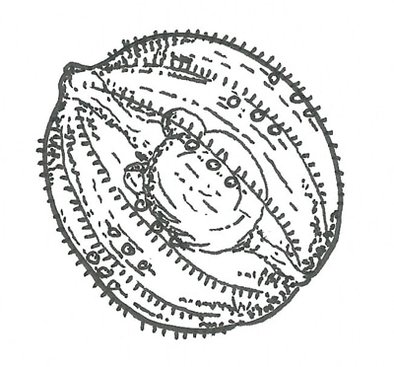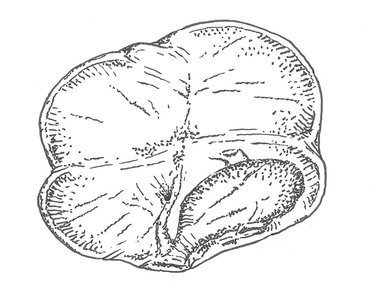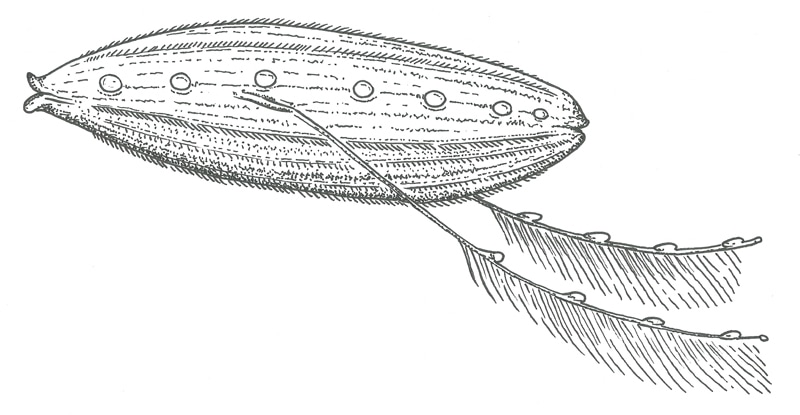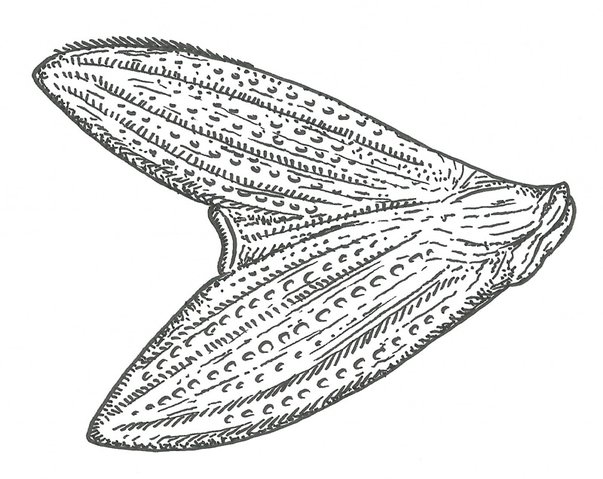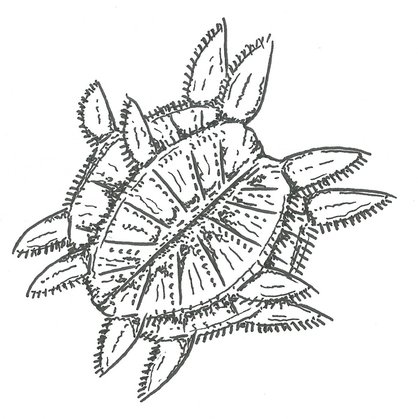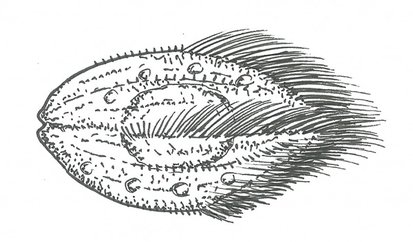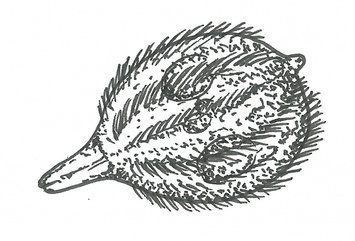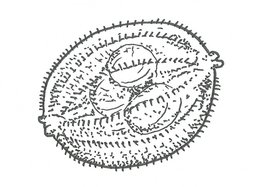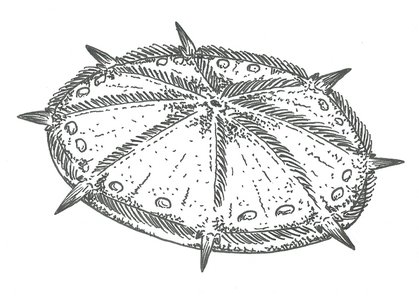Air Jellies - Ctenophora
The ctenophores are among the most varied of the modern aerial fauna. They are distinct from typical marine ctenophores in that the mouth opening is connected both to the stomach, and to a large rear orifice. This allows them to inflate their bodies with air and force it out rearward to provide a burst of speed, sometimes blindingly fast. Additional to this, they are also propelled by the bands of cilia that cover their bodies, which beat back and forth like tiny oars. Their flesh is imbued with many tiny pockets of lighter-than air gas, which serves to keep them aloft. Most members of this group have organs that produce light, usually this will serve to startle predators or attract smaller prey items within reach.
There are quite a variety of diets in this group, many are photosynthesizers which have a green-pall to their flesh, but there are also predatory forms, some of which engulf prey, others having trailing tentacles to snag food.
There are quite a variety of diets in this group, many are photosynthesizers which have a green-pall to their flesh, but there are also predatory forms, some of which engulf prey, others having trailing tentacles to snag food.
Saucer-Creature –
Source: First sighted in Oregon, USA. May 11th, 1950.
This mid-sized aerial ctenophore reaches about 8 meters across, and is most often seen at night. It is able to alter the opacity of its body, from clear, to opaque and reflective. They can move quite quickly, with their flight resembling a skimming stone. Saucer-creatures are very commonly mistaken for UFOs or “flying saucers”. This form is most often native to the lower stratosphere.
Source: First sighted in Oregon, USA. May 11th, 1950.
This mid-sized aerial ctenophore reaches about 8 meters across, and is most often seen at night. It is able to alter the opacity of its body, from clear, to opaque and reflective. They can move quite quickly, with their flight resembling a skimming stone. Saucer-creatures are very commonly mistaken for UFOs or “flying saucers”. This form is most often native to the lower stratosphere.
Saucer type A1, B1 C1 -
Source: Many separate sightings, commonly reported in UFOlogy circles.
This spindle-shaped ctenophore is able to move very quickly through the atmosphere, both by expelling air, and by quickly rotating its body using its propulsive cilia. A maximum of 4 meters across, it is found mostly in the lower stratosphere, where it feeds on certain stages of aeroplankton.
Source: Many separate sightings, commonly reported in UFOlogy circles.
This spindle-shaped ctenophore is able to move very quickly through the atmosphere, both by expelling air, and by quickly rotating its body using its propulsive cilia. A maximum of 4 meters across, it is found mostly in the lower stratosphere, where it feeds on certain stages of aeroplankton.
Saucer type D1, E1, F1 -
Source: Many separate sightings, commonly reported in UFOlogy circles.
This large aerial ctenophore is mostly spotted at night, as it possesses a series of large blinking light organs along its rim. Commonly mistaken for a rather typical flying saucer, it in fact uses its array of lights to attract smaller nocturnal critters which it preys upon. It tends to vary in size depending on condition and age, older individuals can be as much as 12 meters across, spends most of its life in the mid stratosphere.
Source: Many separate sightings, commonly reported in UFOlogy circles.
This large aerial ctenophore is mostly spotted at night, as it possesses a series of large blinking light organs along its rim. Commonly mistaken for a rather typical flying saucer, it in fact uses its array of lights to attract smaller nocturnal critters which it preys upon. It tends to vary in size depending on condition and age, older individuals can be as much as 12 meters across, spends most of its life in the mid stratosphere.
Saucer type D4, G1 -
Source: Many separate sightings, commonly reported in UFOlogy circles.
Another aerial ctenophore which is usually mistaken for an alien spacecraft, or a weather balloon. Reaching up to 10 meters tall and 6 meters across, it is a sluggish photo-synthesizer which will occasionally snatch smaller critters. When spotted by humans, it usually has a silvery metallic colour, this is a defensive tactic that allows the jelly to cloak itself.
Source: Many separate sightings, commonly reported in UFOlogy circles.
Another aerial ctenophore which is usually mistaken for an alien spacecraft, or a weather balloon. Reaching up to 10 meters tall and 6 meters across, it is a sluggish photo-synthesizer which will occasionally snatch smaller critters. When spotted by humans, it usually has a silvery metallic colour, this is a defensive tactic that allows the jelly to cloak itself.
Gizmo –
Source: sighted in Virginia USA, 2000.
This species is quite small, only about a meter long. Usually they are invisible to the naked eye, as they can alter the opacity of their body. All that is seen is a shimmer in the air as they move, but they can be detected by radar. Gizmos cam move incredibly fast when they have to, thanks to how they are able to shunt air through their bodies.
Source: sighted in Virginia USA, 2000.
This species is quite small, only about a meter long. Usually they are invisible to the naked eye, as they can alter the opacity of their body. All that is seen is a shimmer in the air as they move, but they can be detected by radar. Gizmos cam move incredibly fast when they have to, thanks to how they are able to shunt air through their bodies.
Lozenge –
Source: Sighting by Pat Q, West Virginia USA, 1989.
Lozenges can move extremely fast, and are able to change the shape of their bodies as they move. When increasing in speed they become more sleek and bullet-like. As with all aerial ctenophores, propulsion is achieved via the cilia, and by shunting air through the body cavity. It is assumed that they are active predators of the mid stratosphere.
Source: Sighting by Pat Q, West Virginia USA, 1989.
Lozenges can move extremely fast, and are able to change the shape of their bodies as they move. When increasing in speed they become more sleek and bullet-like. As with all aerial ctenophores, propulsion is achieved via the cilia, and by shunting air through the body cavity. It is assumed that they are active predators of the mid stratosphere.
Dijiang –
Source: Chinese mythology.
Appearing like a bright orange hairy balloon, about 2 meters long. The Dijiang is ascribed a great deal of significance in Chinese folklore, usually when it wanders to the earth’s surface from the lower stratosphere. It possesses 2 pairs of wing like rudders and 6 tentacles; it preys mostly on critters which move more slowly than it does.
Source: Chinese mythology.
Appearing like a bright orange hairy balloon, about 2 meters long. The Dijiang is ascribed a great deal of significance in Chinese folklore, usually when it wanders to the earth’s surface from the lower stratosphere. It possesses 2 pairs of wing like rudders and 6 tentacles; it preys mostly on critters which move more slowly than it does.
Foo Fighter –
Source: Sightings by pilots worldwide during WW2.
Dwelling in the lower stratosphere, Foo Fighters are small, fast moving ctenophores some 20 to 30 centimeters across. Feeding mainly on aeroplankton, they are able to move about very quickly and erratically. They produce intense white or red light, when alarmed. Some of the most widely spotted aerial fauna, they caused a great deal of confusion when first spotted during the second world war.
Source: Sightings by pilots worldwide during WW2.
Dwelling in the lower stratosphere, Foo Fighters are small, fast moving ctenophores some 20 to 30 centimeters across. Feeding mainly on aeroplankton, they are able to move about very quickly and erratically. They produce intense white or red light, when alarmed. Some of the most widely spotted aerial fauna, they caused a great deal of confusion when first spotted during the second world war.
Pattern-lights –
Source: Sighted in McHenry Illinois, May 3rd 2010.
Spherical ctenophores about 3 meters wide, this species often flies in formation while producing extremely bright lights. The purpose of this behaviour is unknown, but is often misreported by witnesses as squadrons of alien spacecraft.
Source: Sighted in McHenry Illinois, May 3rd 2010.
Spherical ctenophores about 3 meters wide, this species often flies in formation while producing extremely bright lights. The purpose of this behaviour is unknown, but is often misreported by witnesses as squadrons of alien spacecraft.
Sky Spitter –
Source: Sighted in New York State by Tom D’Ercole, in the summer of 1975.
This unusual ctenophore has only been sighted once, close to the ground, but it is assumed that it mainly lives in the middle stratosphere. It has a nebulous, opaque body, and is able to fill a large sac on its interior with water. This water can be spat as a bluff to startle predators, or possible to immobilise prey.
Source: Sighted in New York State by Tom D’Ercole, in the summer of 1975.
This unusual ctenophore has only been sighted once, close to the ground, but it is assumed that it mainly lives in the middle stratosphere. It has a nebulous, opaque body, and is able to fill a large sac on its interior with water. This water can be spat as a bluff to startle predators, or possible to immobilise prey.
Orbs –
Source: Commonly photographed.
Orbs are one of the very few aerial organisms that is specialised to live at ground level permanently. These tiny creatures are only about as large as a marble or bead, and are generally invisible to the naked eye. This is because they move extremely fast, and can change the opacity of their bodies. Orbs are only ever seen by humans when they are caught in photographs. Orbs feed mainly by photosynthesizing.
Source: Commonly photographed.
Orbs are one of the very few aerial organisms that is specialised to live at ground level permanently. These tiny creatures are only about as large as a marble or bead, and are generally invisible to the naked eye. This is because they move extremely fast, and can change the opacity of their bodies. Orbs are only ever seen by humans when they are caught in photographs. Orbs feed mainly by photosynthesizing.
Cigar –
Source: Sighting in Yukon, Canada, July 1996.
The Cigar is a large predatory ctenophore about 20 meters long. It has numerous light-emitting organs on its body which serve to attract aeroplankton and other small critters, to be snagged by its 2 feeding tentacles. Understandably, with its large lateral lights appearing like portholes, it was mistaken for an alien spacecraft.
Source: Sighting in Yukon, Canada, July 1996.
The Cigar is a large predatory ctenophore about 20 meters long. It has numerous light-emitting organs on its body which serve to attract aeroplankton and other small critters, to be snagged by its 2 feeding tentacles. Understandably, with its large lateral lights appearing like portholes, it was mistaken for an alien spacecraft.
Big Wing –
Source: Sighted in New York State from the 1980’s to the 1990’s.
The largest aerial ctenophore is the big wing, measuring 90 meters across. It is studded with lines of light-emitting organs of various colours, and usually moves quite slowly through the air, mostly using its cilia. Usually they photosynthesize by day in order to feed, but their large mouth also enables them to engulf large prey or floating carrion, if the opportunity arises. Big Wings are frequently mistaken for alien craft or UFOs, but are usually only found in the mid stratosphere.
Source: Sighted in New York State from the 1980’s to the 1990’s.
The largest aerial ctenophore is the big wing, measuring 90 meters across. It is studded with lines of light-emitting organs of various colours, and usually moves quite slowly through the air, mostly using its cilia. Usually they photosynthesize by day in order to feed, but their large mouth also enables them to engulf large prey or floating carrion, if the opportunity arises. Big Wings are frequently mistaken for alien craft or UFOs, but are usually only found in the mid stratosphere.
Ophanim –
Source: The Bible
Glowing bright orange by night, and flapping its array of wing-like fins, this critter was mistaken for an angel by the ancient Israelites. It is a predator, whose glow usually serves to attract smaller prey, though it can create a bright flash to confuse potential predators. Usually they grow to a maximum of 4 meters long.
Source: The Bible
Glowing bright orange by night, and flapping its array of wing-like fins, this critter was mistaken for an angel by the ancient Israelites. It is a predator, whose glow usually serves to attract smaller prey, though it can create a bright flash to confuse potential predators. Usually they grow to a maximum of 4 meters long.
Sogen-bi –
Source: Japanese mythology.
In Japanese myth, these creatures are shown as flying heads engulfed in flames. In reality this is a small aerial ctenophore whose rather long cilia do look somewhat like hair, and which produces a flaming orange flash when alarmed.
Source: Japanese mythology.
In Japanese myth, these creatures are shown as flying heads engulfed in flames. In reality this is a small aerial ctenophore whose rather long cilia do look somewhat like hair, and which produces a flaming orange flash when alarmed.
Star Creature –
Source: Cherokee Mythology
This spherical ctenophore reaches about 5 meters across, and has a small proboscis-like mouth that can be extruded and retracted. It has fairly long cilia, and consistently emits a strong, white light.
Source: Cherokee Mythology
This spherical ctenophore reaches about 5 meters across, and has a small proboscis-like mouth that can be extruded and retracted. It has fairly long cilia, and consistently emits a strong, white light.
Will-o-wisp –
Source: Mythology worldwide.
Will-o-wisp are larger relatives of the orbs, and like them, they live entirely at surface level. Generally this species is most often found in remote areas, often far afield in the country or around bogs and marshes. They produce a large point of white light, and move erratically, resulting in many travellers’ tales of them leading folk astray.
Source: Mythology worldwide.
Will-o-wisp are larger relatives of the orbs, and like them, they live entirely at surface level. Generally this species is most often found in remote areas, often far afield in the country or around bogs and marshes. They produce a large point of white light, and move erratically, resulting in many travellers’ tales of them leading folk astray.
Barcadzy Calh –
Source: Caucasian mythology.
A very fierce sight, this ctenophore reaches about 7 feet across, and produces a bright red, flaming light. It possesses large spines along its side which serve to defend it from larger predators, it is found mostly in the mid stratosphere. When irritated or started, it moves in an erratic spinning pattern.
Source: Caucasian mythology.
A very fierce sight, this ctenophore reaches about 7 feet across, and produces a bright red, flaming light. It possesses large spines along its side which serve to defend it from larger predators, it is found mostly in the mid stratosphere. When irritated or started, it moves in an erratic spinning pattern.
